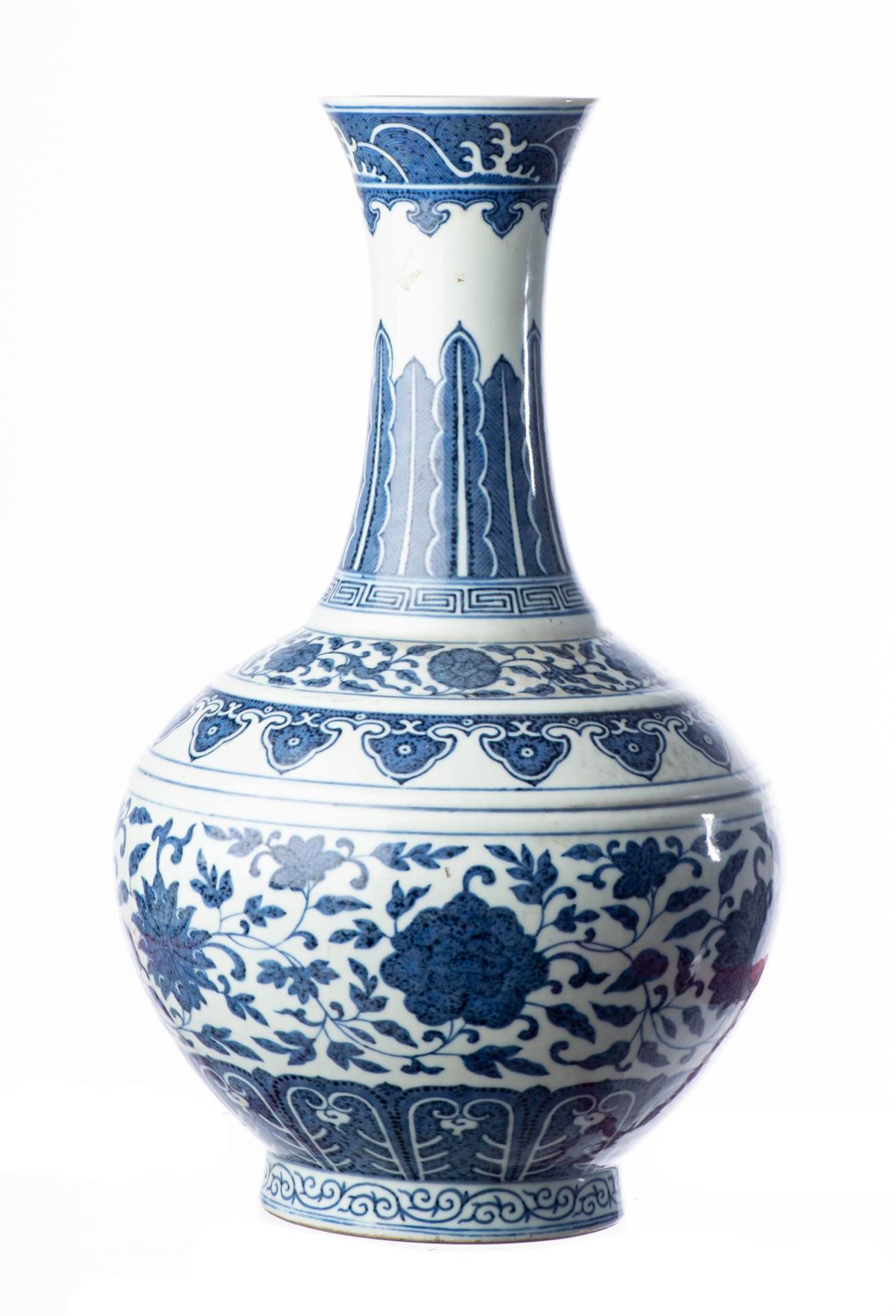Description
CHINA, late Qing. Imperial Chinese porcelain bottle vase (official ware), decorated in blue & white, the globular body painted in the central horizontal register with six different flower heads on scrolled leafy branches including a lotus, a peony, a chrysanthemum and a camellia above a frieze of lotus petals and scrolls at the foot, on a double line. The shoulder has a frieze of ruyi between two lower bulges and an upper bulge, then a horizontal frieze of flowers identical to the one on the body, connected by a twisted branch of foliage above a bulge, the long flared neck is decorated with a band of grecians (keyfret), plantain leaves, ruyi heads and waves. Guangxu mark and period, inscribed below the base Da Qing Guangxu nianzhi H. 38.8 cm Reference: A similar example is in the inventory of the Beijing Gugong and is illustrated in "The Official Kiln Porcelain of the Chinese Qing Dynasty", Shanghai, 2003, p. 233 as well as in Liu Liang-yu "Official and Popular Ch'ing Goods" 1991 no. 5 p. 255 Another example is exhibited in the Shanghai Museum, Shanghai, and published in "Zhongguo taoci quanji", vol. 15, Shanghai, 2000, pl. 2 ; Four similar vases are illustrated in Regina Krahl, "Chinese Ceramics in the Topkapi Saray Museum," vol. III, London, 1986, pl. 2564, one with an elaborate nineteenth-century Ottoman gilt metal lid. One vase is illustrated in the exhibition catalog of S. Marchant&Son "Recent acquisitions 2003" p. 28.29 Another vase bearing the Guangxu mark was sold at SHK on Nov. 13, 1990 as lot 253, another of the same mark currently in the National Palace Museum is illustrated by van Oort in "Chinese Porcelain of the 19th& 20th Century", Tijdstroom, 1977, pl. 47 condition: Good condition, nothing to report Provenance: Geneva collection Note: This Ming-inspired vase has been part of the imperial orders (official ware) since Qianlong and each subsequent reign ordered a number of them. These official ware pieces used to repeat the design of the previous reign with the name of the reigning reign under the base. However, small differences are introduced with each subsequent reign. The foot under Guangxu is thin, high and straight, slightly retracted on the inside and finished as under Qianlong in a rounded shape with a point of oxide at the end of the cover, it is on the other hand sometimes slightly silted on the inside. The paste is fine and white, the body is mounted with a finely refined Kaolin without impurities. The blue pigment comes from Yunnan and produces a fine, rich and very clear color with just a little bit of violet.
16
CHINA, late Qing. Imperial Chinese porcelain bottle vase (official ware), decorated in blue & white, the globular body painted in the central horizontal register with six different flower heads on scrolled leafy branches including a lotus, a peony, a chrysanthemum and a camellia above a frieze of lotus petals and scrolls at the foot, on a double line. The shoulder has a frieze of ruyi between two lower bulges and an upper bulge, then a horizontal frieze of flowers identical to the one on the body, connected by a twisted branch of foliage above a bulge, the long flared neck is decorated with a band of grecians (keyfret), plantain leaves, ruyi heads and waves. Guangxu mark and period, inscribed below the base Da Qing Guangxu nianzhi H. 38.8 cm Reference: A similar example is in the inventory of the Beijing Gugong and is illustrated in "The Official Kiln Porcelain of the Chinese Qing Dynasty", Shanghai, 2003, p. 233 as well as in Liu Liang-yu "Official and Popular Ch'ing Goods" 1991 no. 5 p. 255 Another example is exhibited in the Shanghai Museum, Shanghai, and published in "Zhongguo taoci quanji", vol. 15, Shanghai, 2000, pl. 2 ; Four similar vases are illustrated in Regina Krahl, "Chinese Ceramics in the Topkapi Saray Museum," vol. III, London, 1986, pl. 2564, one with an elaborate nineteenth-century Ottoman gilt metal lid. One vase is illustrated in the exhibition catalog of S. Marchant&Son "Recent acquisitions 2003" p. 28.29 Another vase bearing the Guangxu mark was sold at SHK on Nov. 13, 1990 as lot 253, another of the same mark currently in the National Palace Museum is illustrated by van Oort in "Chinese Porcelain of the 19th& 20th Century", Tijdstroom, 1977, pl. 47 condition: Good condition, nothing to report Provenance: Geneva collection Note: This Ming-inspired vase has been part of the imperial orders (official ware) since Qianlong and each subsequent reign ordered a number of them. These official ware pieces used to repeat the design of the previous reign with the name of the reigning reign under the base. However, small differences are introduced with each subsequent reign. The foot under Guangxu is thin, high and straight, slightly retracted on the inside and finished as under Qianlong in a rounded shape with a point of oxide at the end of the cover, it is on the other hand sometimes slightly silted on the inside. The paste is fine and white, the body is mounted with a finely refined Kaolin without impurities. The blue pigment comes from Yunnan and produces a fine, rich and very clear color with just a little bit of violet.
